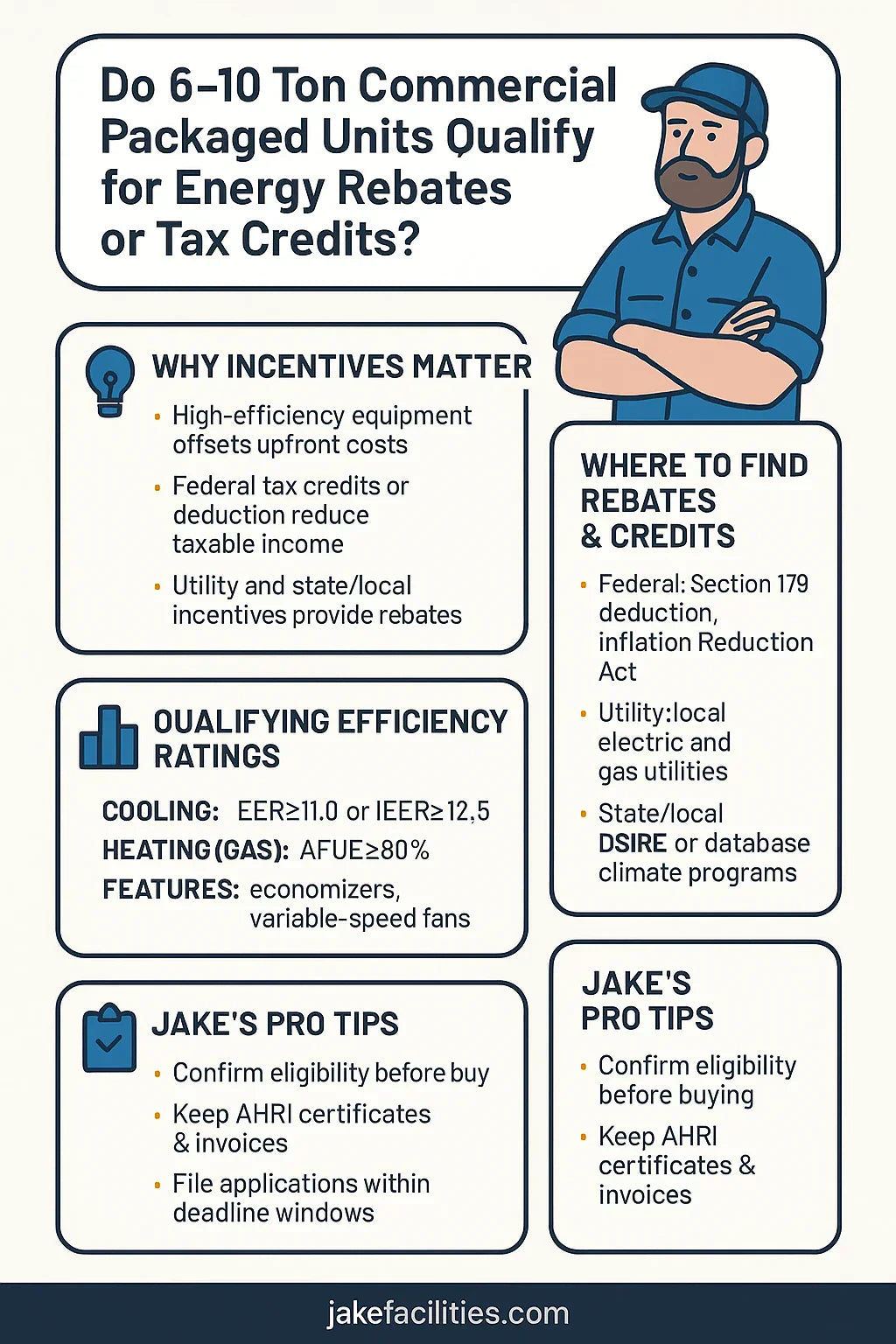(Jake’s guide to finding and securing HVAC incentives without getting lost in the fine print)
🏢 1. Introduction – Why Incentives Matter for Large HVAC Purchases
When you’re replacing a 6–10 ton commercial packaged AC & gas furnace unit, you’re not just buying a piece of equipment—you’re making a capital investment that can easily run $15,000–$25,000 or more installed.
The good news? Energy rebates and tax credits can significantly offset that cost.
-
Federal tax deductions can reduce your taxable income.
-
Utility rebates put cash back in your pocket.
-
State and local programs can stack on top of both.
Why do these programs exist?
-
To encourage businesses to upgrade to higher-efficiency equipment.
-
To reduce strain on the electrical grid during peak demand.
-
To lower overall carbon emissions from commercial buildings.
📜 2. Federal Tax Credits & Deductions
A. Section 179 Commercial HVAC Deduction (U.S.)
-
Allows businesses to deduct the full purchase price of qualifying HVAC equipment in the year it’s placed in service.
-
Applies to new commercial HVAC equipment, including 6–10 ton packaged units.
-
2025 limit for Section 179 deductions: $1.16 million (subject to phase-out).
Key Steps:
-
Ensure the unit is installed and operational within the tax year.
-
Keep all receipts and proof of installation.
B. Inflation Reduction Act (IRA) Incentives
-
Expanded incentives for energy-efficient commercial equipment.
-
Bonus deductions for projects that meet prevailing wage and apprenticeship requirements.
-
Higher savings for projects in energy communities or low-income areas.
C. Energy-Efficient Commercial Building Deduction (Section 179D)
-
Allows a tax deduction for energy-efficient building systems, including HVAC.
-
Efficiency improvements must meet ASHRAE 90.1 standards.
-
Deduction value varies based on kBtu/sq ft improvement.
💰 3. Utility Rebates & Regional Programs
Most major electric and gas utilities offer rebates for high-efficiency rooftop units—often tied to EER/IEER ratings and furnace AFUE.
Typical Examples for a 6–10 Ton Unit (2025 rates):
-
$150–$250 per ton for qualifying EER/IEER performance
-
$300–$600 bonus for advanced economizer integration
-
$150–$250 for demand-controlled ventilation features
Important:
-
Rebate eligibility is based on AHRI-certified performance data.
-
You’ll often need to submit the AHRI certificate with your application.
-
Programs are usually first-come, first-served—funding can run out before year-end.
🌎 4. State & Local Incentives
A. Where to Search
-
DSIRE (Database of State Incentives for Renewables & Efficiency) –
-
State energy offices often maintain their own lists of available programs.
-
Local climate action plans may include targeted funding for HVAC retrofits.
B. Examples
-
California: Commercial rebates for high-IEER rooftop units can reach $1,200+ per unit.
-
New York: NYSERDA offers performance-based incentives for high-efficiency packaged units.
-
Texas: Some utilities offer doubled incentives during grid reliability improvement periods.
📊 5. Qualifying Efficiency Ratings for Rebates
To qualify, most programs set minimum performance thresholds:
Cooling:
-
EER (Energy Efficiency Ratio): Often 11.0+ for rebates
-
IEER (Integrated EER): 14.0+ for tiered bonuses
Heating (Gas Furnace Section):
-
AFUE (Annual Fuel Utilization Efficiency): 80–90%+
Features That Boost Eligibility:
-
Variable-speed supply fans
-
Advanced economizers with fault detection
-
Demand-controlled ventilation sensors
🛠 6. Jake’s Steps to Securing Incentives
-
Check eligibility before you buy – Don’t assume any high-efficiency unit qualifies; requirements vary.
-
Work with an AHRI-certified match – Mismatched components can void rebate eligibility.
-
Gather documentation early – Model numbers, AHRI certificate, efficiency ratings, and invoices.
-
File promptly – Utility rebates often have a 60–90 day post-install window.
-
Track payments – Some rebates arrive as checks, others as bill credits.
📑 7. Case Study: Real-World Savings
Scenario:
-
Replacement of a 20-year-old 8-ton RTU in a 12,000 sq ft retail building.
-
Installed cost of new high-IEER unit: $18,500.
-
Utility rebate: $1,600.
-
Section 179 deduction tax savings: $3,885 (21% corporate tax rate).
-
Net effective cost: $13,015.
Payback:
-
Annual energy savings: $1,200/year.
-
Payback period: ~10 years including incentives.
📝 8. Jake’s Pro Tips
-
Stack programs when possible – Federal deduction + state rebate + utility rebate = maximum ROI.
-
Don’t skip economizers – They can push your unit into a higher rebate tier.
-
Ask about midstream incentives – Some rebates are built into the contractor’s invoice price.
-
Save your AHRI certs – They’re the #1 most requested rebate document.
-
Watch funding cycles – Many programs reset January 1, but some renew mid-year.
In the next topic we will know more about: Is a 6–10 Ton Packaged Unit Right for Your Building? Sizing, Load Calculations & Zoning Tips







